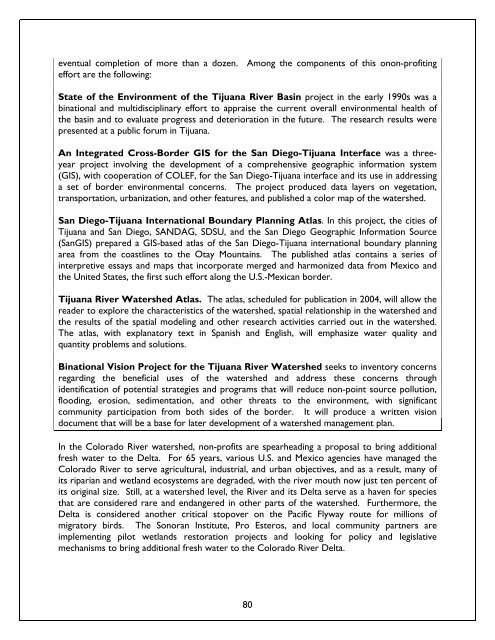Blurred Borders - International Community Foundation
Blurred Borders - International Community Foundation
Blurred Borders - International Community Foundation
You also want an ePaper? Increase the reach of your titles
YUMPU automatically turns print PDFs into web optimized ePapers that Google loves.
eventual completion of more than a dozen. Among the components of this onon-profiting<br />
effort are the following:<br />
State of the Environment of the Tijuana River Basin project in the early 1990s was a<br />
binational and multidisciplinary effort to appraise the current overall environmental health of<br />
the basin and to evaluate progress and deterioration in the future. The research results were<br />
presented at a public forum in Tijuana.<br />
An Integrated Cross-Border GIS for the San Diego-Tijuana Interface was a threeyear<br />
project involving the development of a comprehensive geographic information system<br />
(GIS), with cooperation of COLEF, for the San Diego-Tijuana interface and its use in addressing<br />
a set of border environmental concerns. The project produced data layers on vegetation,<br />
transportation, urbanization, and other features, and published a color map of the watershed.<br />
San Diego-Tijuana <strong>International</strong> Boundary Planning Atlas. In this project, the cities of<br />
Tijuana and San Diego, SANDAG, SDSU, and the San Diego Geographic Information Source<br />
(SanGIS) prepared a GIS-based atlas of the San Diego-Tijuana international boundary planning<br />
area from the coastlines to the Otay Mountains. The published atlas contains a series of<br />
interpretive essays and maps that incorporate merged and harmonized data from Mexico and<br />
the United States, the first such effort along the U.S.-Mexican border.<br />
Tijuana River Watershed Atlas. The atlas, scheduled for publication in 2004, will allow the<br />
reader to explore the characteristics of the watershed, spatial relationship in the watershed and<br />
the results of the spatial modeling and other research activities carried out in the watershed.<br />
The atlas, with explanatory text in Spanish and English, will emphasize water quality and<br />
quantity problems and solutions.<br />
Binational Vision Project for the Tijuana River Watershed seeks to inventory concerns<br />
regarding the beneficial uses of the watershed and address these concerns through<br />
identification of potential strategies and programs that will reduce non-point source pollution,<br />
flooding, erosion, sedimentation, and other threats to the environment, with significant<br />
community participation from both sides of the border. It will produce a written vision<br />
document that will be a base for later development of a watershed management plan.<br />
In the Colorado River watershed, non-profits are spearheading a proposal to bring additional<br />
fresh water to the Delta. For 65 years, various U.S. and Mexico agencies have managed the<br />
Colorado River to serve agricultural, industrial, and urban objectives, and as a result, many of<br />
its riparian and wetland ecosystems are degraded, with the river mouth now just ten percent of<br />
its original size. Still, at a watershed level, the River and its Delta serve as a haven for species<br />
that are considered rare and endangered in other parts of the watershed. Furthermore, the<br />
Delta is considered another critical stopover on the Pacific Flyway route for millions of<br />
migratory birds. The Sonoran Institute, Pro Esteros, and local community partners are<br />
implementing pilot wetlands restoration projects and looking for policy and legislative<br />
mechanisms to bring additional fresh water to the Colorado River Delta.<br />
80















